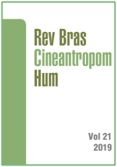Habilidades motoras de crianças com transtorno do espectro autista
DOI:
https://doi.org/10.1590/1980-0037.2019v21e60515Resumo
O objetivo deste estudo é descrever as variáveis de hábitos de vida associadas as habilidades motoras de crianças com transtorno do espectro autista de oito a 10 anos residentes na cidade de Pelotas/RS. Foi respondido um questionário sobre o estilo de vida e aplicado o Test of Gross Motor Development-2 (TGMD-2) para avaliação das habilidades motoras. Foi utilizado o teste T independente, ANOVA e teste de Wilcoxon para comparação de médias. Fizeram parte do estudo 49 indivíduos (42 do sexo masculino). Os resultados indicam que quando maior o grau de TEA, melhor são as habilidades motoras. As crianças que tomam medicamento apresentam maiores déficits nas habilidade motoras. Maiores escores nas habilidades motoras, estão associados a maior participação nas aulas de educação física. As habilidades motoras estão fortemente associadas a independência nas atividades de vida diária, alimentar-se, higiene pessoal, arrumar-se e banhar-se. Pode-se perceber a importância da criação de programas de AF visando a melhora nas habilidades motoras dessa população.
Referências
McPhillips M., Finlay J, Bejerot S, Hanley M. Motor Deficits in Children With Autism Spectrum Disorder: A Cross-Syndrome Study. Autism Res 2014;7:664–676
Freitag CM, Kleser C, Schneider M, Gontard A. Quantitative Assessment of Neuromotor Function in Adolescents with High Functioning Autism and Asperger Syndrome. J Autism Dev Disord 2007;37:948–959.
Rinehart NJ, Bellgrove MA, Tonge BJ, Brereton AV, Howells-Rankin D, Bradshaw JL. An Examination of Movement Kinematics in Young People with High-functioning Autism and Asperger's Disorder: Further Evidence for a Motor Planning Deficit. J Autism Dev Disord 2006;36(6): 757–767.
Kaur M, Srinivasan SM, Bhat AN. Comparing motor performance, praxis, coordination, and interpersonal synchrony between children with and without Autism Spectrum Disorder (ASD). Res Dev Disabil 2018;72:79-95.
Stins JF, Emck C. Balance Performance in Autism: A Brief Overview. Front Psychol 2018;9:901.
Green D, Charman T, Pickles A, Chandler S, Loucas T, Simonoff E, Baird G. Impairment in movement skills of children with autistic spectrum Disorders. Dev Med Child Neurol 2009;51(4):311-6.
Krüger GR. Atividade física e barreiras em crianças com autismo de Pelotas. [Dissertação de Mestrado- Programa de pós-graduação da Escola Superior de Educação Física] Pelotas(RS): Universidade Federal de Pelotas; 2015.
Must A, Phillips SM, Curtin C, Bandini LG. Barriers to physical activity in children with autism spectrum disorders: relationship to physical activity and screen time. J Phys Act Health 2015;12(4): 529–534.
Marques AC. O perfil do estilo de vida de pessoas com Síndrome de Down e normas para avaliação da aptidão física [Tese de Doutorado –Programa de pós-graduação da Escola Superior de Educação Física] Porto Alegre(RS): Universidade Federal do Rio Grande do Sul; 2008.
Sowa M, Meulenbroek R. Effects of physical exercise on Autism Spectrum Disorders: A meta-analysis. Res Autism Spectr Disord 2012; 6:46–57.
Ulrich D. The test of gross motor development. Austin: Prod-Ed; 2000.
Valentini N. Percepções de Competência e Desenvolvimento Motor de meninos e meninas: um estudo transversal. Movimento 2002;8(2):51-62.
Staples, KL. Reid, G. J. Fundamental movement skills and autism spectrum disorders. Autism Dev Disord 2010;40:209.
Memari AH, Ghaheri B, Ziaee V, Kordi R, Hafizi S, Moshayedi P. Physical activity in children and adolescents with autism assessed by triaxial accelerometry. Pediatr Obes 2013;8(2):150-8.
Lima HR, Viana FC. Importância da educação física para inserção escolar de crianças com transtorno do espectro do autismo (TEA). Rev Cie Multidiscip Núcleo Conhecim 2016;1(10):261-280.
Jones RA, Downing K, Rinehart NJ, Barnett LM, May T, McGillivray JA, et al. Physical activity, sedentary behavior and their correlates in children with Autism Spectrum Disorder: A systematic review. Plos One 2017;12(2):e0172482.
Ayvazoglu NR, Kozub FM, Butera G, Murray MJ. Determinants and challenges in physical activity participation in families with children with high functioning autism spectrum disorders from a family systems perspective. Res Dev Disabil 2015;47:93-105.
Orsmond GI, Kuo H-Y. The daily lives of adolescents with an autism spectrum disorder: Discretionary time use and activity partners. Autism 2011;15: 579-599.
Downloads
Publicado
Edição
Seção
Licença

Direitos Autorais para artigos publicados nesta revista são do autor, com direitos de primeira publicação para a revista. Em virtude da aparecerem nesta revista de acesso público, os artigos são de uso gratuito, com atribuições próprias, em aplicações educacionais e não-comerciais, desde que seja dada a atribuição. Esta obra foi licenciada com uma Licença Creative Commons Atribuição 4.0 Internacional - CC BY


